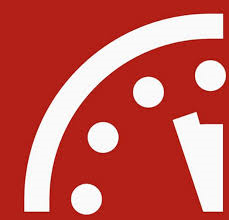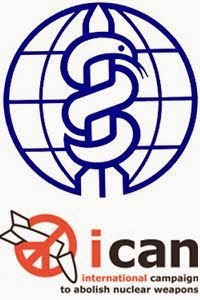Editor's Note: The following opinion by Patrick Hiller, a Professor in the Conflict Resolution Department at Portland State University, Portland, OR, in The Cap Times is the perfect response to this week's announcement by Secretary of Defense Chuck Hagel about plans to pour yet more money into the government's already out-of-control nuclear weapons spending spree. Hagel once again parroted the indefensible party line (this is beginning to sound like a broken record): “Our nuclear deterrent plays a critical role in securing U.S. national security.”
***************
Patrick T. Hiller: Don't modernize nukes, eliminate them
Did you notice? Secretary of Defense Chuck Hagel just announced plans to massively “upgrade” the U.S. nuclear arsenal. Should we numbly accept new plans by our government to revitalize systems which without doubt are the greatest threat to human survival? Did we forget that our president told the world in Prague in 2009 that America is committed to seeking peace and security by creating a world without nuclear weapons, and for that announced intention received a Nobel Peace Prize?
The concerns outlined by Hagel could have provided an excellent opportunity to significantly implement the needed steps away from nuclear weapons. Cheating scandals on qualification tests or misconduct by top officers overseeing key nuclear programs certainly are worrisome. Even more worrisome is the fact that nuclear weapons still exist and are not considered an abnormality. The more troubling aspect of Hagel’s announcement is the broader nuclear modernization program. Making sure the so-called triad of strategic deliver systems grows, the Pentagon can plan for plenty of new missile submarines, new bombers, and new and refurbished land-based missiles. The Monterey Institute of International Studies sums up their well-documented report: “Over the next 30 years, the United States plans to spend approximately $1 trillion maintaining the current arsenal, buying replacement systems, and upgrading existing nuclear bombs and warheads.”
Even the most doubtful among us will see the contradiction between the commitment of seeking a world without nuclear weapons and “revamping the nuclear enterprise” as Hagel noted in his keynote speech at the Reagan National Defense Forum last week.
It appears that the absence of the Cold War and the soothing rhetoric about a world without nuclear weapons keeps us complacent — can anyone imagine one million people demonstrating against nuclear weapons as they did in New York City in 1982? That same year was the largest exercise in direct democracy (voting on an issue rather than representatives to decide "our" view) when voters in referendums in about half the states decided overwhelmingly to call for a freeze on research, development, production and deployment of nuclear weapons. I think we the people should make ourselves heard again. We should say:
First, nuclear deterrence is a myth and ought to be rejected by all people and governments. In the Santa Barbara Declaration by the Nuclear Age Peace Foundation, the major problems outlined with nuclear deterrence are: 1) its power to protect is a dangerous fabrication; 2) the assumption of rational leaders; 3) the threatening of mass murder is illegal and criminal; 4) it is immoral; 5) it diverts badly needed human and economic resources; 6) its ineffectiveness against non-state extremists; 7) its vulnerability to cyber-attacks, sabotage and error; and 8) setting an example to pursue nuclear weapons as deterrence.
Second, diminish the role of nuclear weapons in security policies. Once the “unthinkable” nuclear option no longer plays a central role in security planning, and once the nuclear weapons are de-coupled from conventional military forces, the elimination of nuclear arsenals can be facilitated.
Third, don’t wait for conditions to be ripe. There is statistical certainty that a nuclear weapon will be used at some point. The only way to make sure it does not happen is to eliminate all.
Fourth, encourage compliance with all international treaties and create new ones that will ban and eliminate all nuclear weapons worldwide.
Fifth, move our government toward unilateral disarmament. Without a nuclear arsenal we are not making anyone less secure. What if the United States would take the lead in a global “disarmament race”? After decades of international military interventionism the United States might become a loved and respected country again.
Sixth, recognize the role of nuclear weapons in the chain of global violence ranging from hand guns on the streets to catastrophic environmental and humanitarian consequences of nuclear weapons use. Violence and the threat of violence on all levels perpetuates violence.
No Russian takeover of the Ukraine, Chinese territorial claims, or even Pakistani expansion of nuclear arsenal makes it any more logical to revitalize our nuclear arsenals. We can reject the myth of nuclear deterrence and we can help the government shift the spending priorities to health care, education, infrastructure, the environment, renewable energy, low-income housing and many more important areas. Currently our public conscience is lacking urgency with regard to nuclear weapons. We owe it to ourselves and our children to activate this urgency and make the elimination of nuclear weapons a step toward a world beyond war.
Patrick. T. Hiller, Ph.D., Hood River, Oregon, syndicated by PeaceVoice, is a conflict transformation scholar, professor, on the Governing Council of the International Peace Research Association, and director of the War Prevention Initiative of the Jubitz Family Foundation. This column was provided by PeaceVoice.
Source URL: http://host.madison.com/ct/news/opinion/column/patrick-t-hiller-don-t-modernize-nukes-eliminate-them/article_8168fbd0-4221-54e9-b48b-6120bb94f7b9.html
No Nuclear "fire and fury" Ever Again! Preventing the Unthinkable!
-
Dear Friends of a world free of nuclear weapons,
I wouldn't normally send another GZNonviolenceE-Newsletter so soon, but
these are anything but normal ti...
6 years ago












